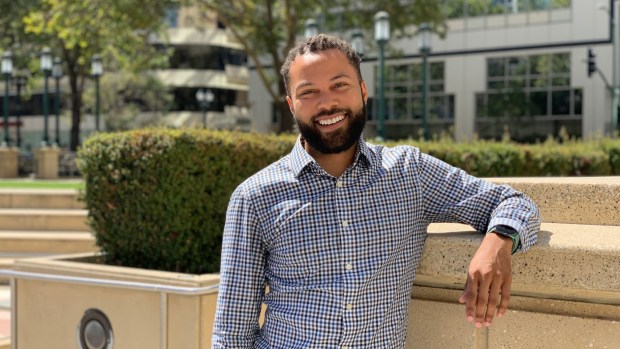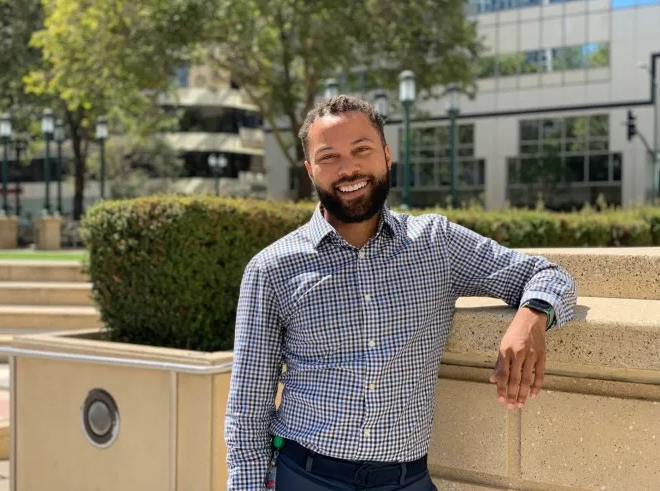
Warren Logan, policy director of mobility and interagency relations for the mayor’s office of Oakland, which in April became the first city to launch “Slow Streets,” has been at the forefront of the movement to create more space for safe, socially-distanced transportation and recreation during COVID-19.
I first heard about Warren in an August 2019 CityLab interview in which he shared his desire to rewrite the script for city planning; Instead of asking people to come to you, go to them and get their view of the problem and their ideas for a solution. I absolutely loved his approach.
In retrospect it’s kind of sad that it was revolutionary for Warren to call for city planner do a better job of engaging communities, going from planning on or for to planning with. Of course, as Logan mentioned a few times during our talk, Oakland is not perfect when it comes to equity or community engagement, but I still think there’s a lot that Chicago can learn from Oakland. Similar to Chicago’s Office of Equity and Racial Justice, Oakland has a Department of Race and Equity whose work is intended to eliminate racial disparities and achieve racial equity.
Last month Streetblog USA’s Jeff Wood also did an interview with Warren on the nuts-and-bolts of implementing Slow Streets, including community input issues. I was delighted to recently have the opportunity to talk to Warren myself and get his perspective on how we can work towards racial equity within a mobility framework.
Courtney Cobbs: What does equity within the Oakland Department of Transportation look like?
Warren Logan: The department of transportation is actually one of the newest departments in the city of Oakland; we launched three years ago. We recognized the injustices many low-income communities and communities of color are impacted by. The department of transportation is committed to using data to correct those injustices when it comes to transportation: from looking at how equitably potholes are filled, to prioritizing certain communities for multi-million dollar corridor improvement projects.
Each one of our processes asks the question, “How are we advancing equity?” Each one of the project managers has to state how a project will advance equity. We also make sure we’re asking the right questions so we can collect the right data. We want the data to reflect the challenges people are facing and we want the outcomes to reduce or eliminate those challenges.
Another way we advance equity is by including the voices of community members where we are working. Through our consultancy work, we have hired on community-based groups and advocacy groups that reflect the hearts and minds of community members. We see it as bringing them into the process and giving them the tools to do the work they feel is critical for their communities.
CC: A recent thought I’ve had in regards to my own neighborhood is dividing public space equitably by mode share, providing more dedicated space for people walking, riding transit, and biking. What are your thoughts about that?
WL: I try to discourage people from looking at existing modal splits and usage as a way to [determine how to allocate] space because you end up discouraging climate goals. The way we look at the conversation is by looking at the larger problem: People are being killed on the road. It’s the department’s responsibility to keep people safe and if bike lanes are a way to do that, great. The key ingredient though is to really understand what the problem is.
If you’re a hammer, everything looks like nails. It’s important for transportation planners to get out of their silo. Planners need to translate the issue into residents’ everyday lives. People are not coming to us saying “Give us more bike lanes because they will make us safer,” they’re saying “Why do people keep getting hit by cars and why can’t I walk down the street without being harassed?” When it came to the issue of street harassment, we paired our street safety team and neighborhood crime prevention groups to look at intersectional ways to advance our goals together.
The need to dig a little deeper was reflected during Oakland’s rollout of Slow Streets. A lot of folks in our communities of color recognize why DOT created Slow Streets yet they wanted to understand how it became a priority during COVID-19. Folks pointed to the barricades and said, “This is not advancing our goal.” Initially we thought, “I guess they don’t like Slow Streets” but I challenged the team to think through,”What’s the problem they’re trying to address? Let’s dig deeper.” Several conversations later it was discovered that the community saw a need for testing. Due to managing our testing program I was able to bridge that gap. I use that story as an allegory: Civil servants shouldn’t be so narrowly focused. The questions we should be asking are, “How can we, the city, help you? How can you thrive in your community and what are the barriers preventing you from doing so?” Based on the feedback we can bring back a menu of options to help the community thrive.
Oakland’s transportation department recently created the Essential Places program in response to feedback from residents of communities that were underrepresented when the DOT originally collected input on the routes that eventually became Slow Streets. Essential Places are temporary safety improvements, such as using traffic cones to create pedestrian islands, installed to improve access to grocery stores, food distribution sites, and COVID-19 test sites. The first Essential Place was created at an intersection within the city’s high injury network (the same concept as Chicago’s High Crash Corridors). This is an example of the city intelligently using data to help choose the locations for COVID-19 transportation interventions.
CC: I love that! Thank you.
WL: This is hard work! I’m not saying we got this right. Our approach is to be authentic. There were shouting matches and hurt feelings and we came back for more the next day. Our heart is in the right place. The main reason people come to work for us is because we stand for something. It’s really rewarding to work with people who are so committed to their community and would do anything to help people feel safe and healthy. That’s what equity looks like: empowering community members in whatever way you can to give them the tools to make their lives better. That can look like a job in local government or contracting with neighborhood associations and bringing them on as advisory groups, to name a few.
At the end of my interview with Logan I was left pondering how equity-focused transportation planning could look in Chicago. Currently CDOT is not all that transparent and I’m envious of how responsive Oakland’s DOT has been to residents. Warren asserted that Oakland’s Mayor Libby Schiff is committed to equity, and added equity is weaved into many city meetings. It seemed like a different world compared to Chicago where it seems Mayor Lightfoot picks and chooses when equity can be applied. I’m left with more questions than answers but I do believe Oakland can serve as a model for a more equitable mobility landscape here in Chicago.






